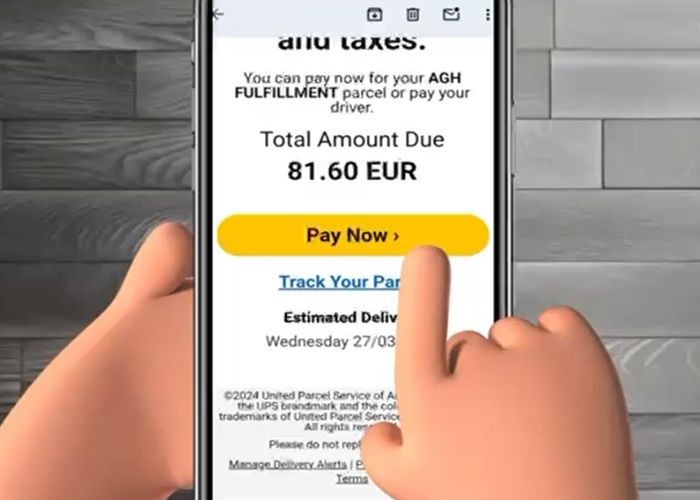Detecting Delivery Scams: How to Protect Your Payment Details
Introduction
Detecting Delivery Scams: How to Protect Your Payment Details
In today’s digital era, scammers are constantly devising new ways to trick individuals into disclosing their sensitive information. One prevalent tactic is the delivery scam, a form of smishing attack where you receive a text message claiming that a package is waiting for you, often accompanied by a demand for payment to release it. While the message might seem plausible—especially if you are expecting a delivery—this type of scam is designed to steal your payment details and compromise your financial security. This guide will explain the warning signs of delivery scams, outline the steps you should take if you encounter such a message, and provide best practices to safeguard your payment information.
Understanding Delivery Scams
Delivery scams play on our natural expectations of receiving parcels or packages. Typically, these scams involve a text message or email that claims you have an unexpected package. The message usually includes a link or instructions to pay a fee to release the package. In many cases, the message might mention details that sound familiar or even include your name to increase the level of trust. However, scammers use these tactics to lure you into clicking on links that lead to phishing websites or to directly steal your payment details.
The core of these scams is smishing—a combination of SMS and phishing. Instead of using email, attackers send text messages that create a sense of urgency, prompting you to act immediately without giving the matter much thought. The urgency is a key component of these scams; the message might imply that the package is about to be returned to the sender or that a limited-time offer is at stake. This pressure tactic is intended to make you bypass the usual caution you would exercise when handling unexpected financial transactions.
Warning Signs of a Delivery Scam
There are several red flags that can help you determine if a delivery notification is a scam:
- Unexpected Messages: If you receive a message about a package you weren’t expecting, take a moment to question its legitimacy. Even if you recently ordered something, check your order history rather than assuming the text is genuine.
- Payment Requests: Authentic courier services or retailers rarely, if ever, ask you to pay a fee to release your package through a text message. They usually require payment during the ordering process.
- Suspicious Links: Be cautious if the message contains a link or asks you to download an app. Scammers often direct you to a phishing site designed to capture your credit card or personal details.
- Generic or Vague Details: If the message lacks specific information about your order or includes generic greetings, it could be a sign that the text was sent to a broad audience.
- Pressure Tactics: Scammers often use urgent language to compel you to act quickly. If the message stresses immediate action without allowing you time to think, it’s a strong indication that something is amiss.
Recognizing these warning signs is the first step in protecting yourself from delivery scams.
Immediate Steps to Take if You Receive a Suspicious Delivery Message
If you encounter a text message that appears to be a delivery notification, take these immediate actions:
- Do Not Click on Any Links: Refrain from clicking the link provided in the message. It may lead you to a fake website that is designed to steal your payment information.
- Verify with the Courier: Instead of using any contact details provided in the message, look up the official phone number or website of the courier service. Call them directly to confirm whether a package is indeed waiting for you.
- Check Your Order History: If you recently placed an order, log in to your account on the retailer’s official website to review the status of your delivery. This helps confirm if the message is legitimate.
- Avoid Providing Personal Details: Do not respond to the message with any personal or payment information. Legitimate companies will not request sensitive details via text message.
- Report the Scam: If you determine the message is fraudulent, report it to your mobile service provider and the appropriate authorities. This helps prevent others from falling victim to similar scams.
By following these steps, you can quickly mitigate the risk of becoming a victim of a delivery scam.
Best Practices for Preventing Delivery Scams
Adopting proactive measures is crucial for safeguarding your payment details and protecting your digital security. Consider the following best practices:
- Be Skeptical of Unexpected Notifications: Always question the legitimacy of delivery notifications, especially if they come at unexpected times or ask for immediate payment.
- Use Official Channels: When in doubt, always contact the courier or retailer using verified contact information found on their official website. This eliminates the risk of being misled by fraudulent messages.
- Enable Transaction Alerts: Many banks and payment services offer real-time alerts for any transactions on your account. Enabling these alerts helps you quickly identify any unauthorized charges.
- Keep Your Devices Secure: Ensure that your smartphone and other devices are protected with updated antivirus software and security patches. This helps safeguard against malware and phishing attempts.
- Educate Yourself and Others: Stay informed about the latest scams and share your knowledge with friends, family, and colleagues. Awareness is a powerful tool in preventing fraud.
- Review Privacy Settings: Adjust your social media and online account settings to limit the amount of personal information that scammers can access. The less information available, the lower the risk of targeted scams.
Implementing these best practices will significantly reduce your vulnerability to delivery scams and other forms of smishing attacks.
Conclusion
Delivery scams are a common tactic used by cybercriminals to steal payment details and compromise financial security. By understanding the nature of these scams and recognizing the warning signs—such as unexpected messages, payment requests, and pressure tactics—you can take immediate action to protect yourself. Always verify any delivery notifications through official channels rather than relying on the details provided in suspicious messages. Adopting a cautious approach and following best practices is essential to maintaining your financial security in an era where scams are increasingly sophisticated.
Staying vigilant and informed about the latest fraud tactics will empower you to navigate the digital landscape with confidence. Remember, if a delivery notification asks for payment or personal information in a way that seems unusual, it is most likely a scam designed to exploit your trust. Protect your payment details by verifying with the courier directly and avoiding any links or contact details provided in unsolicited messages.
Delivery scams are common in smishing attacks. Always verify delivery requests through official channels and avoid clicking suspicious links.


.png)




















